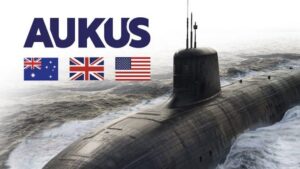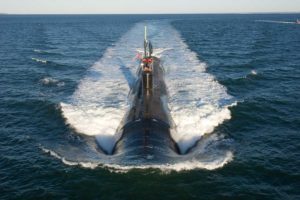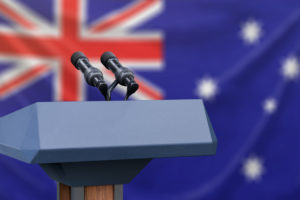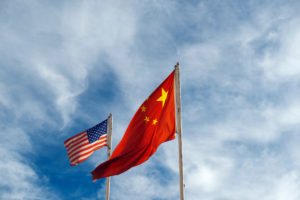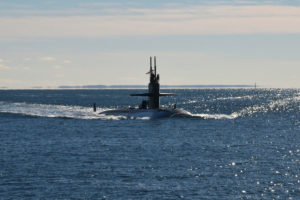On September 15, 2021, Australia, the United Kingdom, and the United States announced a wide-ranging technology-sharing partnership agreement known as AUKUS. Primarily seen as a response to growing Chinese antagonism in the Pacific, the deal institutionalises 17 trilateral working groups on topics such as artificial intelligence, hypersonics, and quantum technologies. However, the majority are dedicated to sharing information on conventionally armed nuclear-powered submarines, as Australia intends to acquire at least eight at the earliest opportunity, abandoning a previous deal to obtain 12 conventionally powered submarines from France. If realised, Australia would become the seventh state to possess such a capability and the only non-nuclear-weapon–possessing state to do so. While the deal poses non-proliferation issues and must overcome practical problems for delivery, it would be a positive step in terms of burden-sharing, though it must be incorporated into a wider agenda if it’s intended to uphold a “rules-based international order” (RBIO).
The main issue with AUKUS from an RBIO perspective is that actualising the deal will require the transfer of large amounts of highly enriched weapons-grade uranium (HEU) to Australia, as it lacks its own enrichment capability and HEU is currently the only fuel used by British and American nuclear-powered submarines. As the name suggests, weapons-grade uranium is particularly apt for use in nuclear weapons, and the several tons required would be sufficient for hundreds of nuclear weapons if misappropriated. Transferring “dangerous nuclear bomb-making material” abroad would starkly contrast with Obama-era policies that attempted to “secure and minimize” HEU use worldwide. Low-enriched uranium (LEU) fuel is already in use by China and France, and its transfer would not pose the same proliferation concerns, but it has its own technical drawbacks and has already been rejected as unsuitable for Australia’s needs. Although the United States has funded its own LEU naval propulsion development programme, this effort is not expected to reach fruition until the 2040s. This leaves proliferation-sensitive HEU as the only realistic fuel available in the timeframes envisaged by AUKUS.
China and Russia have implied that this reliance on HEU is evidence that AUKUS breaks the Treaty on the Non-Proliferation of Nuclear Weapons (NPT), a “critical pillar” of the rules-based international order. This is ostensibly not the case; the use of nuclear material for non-explosive military “non-peaceful activities” is permitted by paragraph 14 of the International Atomic Energy Agency’s (IAEA) template Comprehensive Safeguards Agreement and is exempt from routine safeguards during its use. This provision is in place in the agreement between Australia and the IAEA, and analysts have noted that AUKUS poses “no real [direct proliferation] concerns.” Further, the undetected diversion of nuclear material would be challenging, as it remains “practicably inaccessible,” sealed within reactors. Additionally, AUKUS partners have jointly committed to the “highest standards for safeguards, transparency, verification, and accountancy measures.”
Yet, by making use of the military-purposes ”loophole,” AUKUS could open the nuclear proliferation Pandora’s box. A more expansive interpretation of the ill-defined non-peaceful activities provisions could enable a state with enrichment capabilities to produce and accumulate fissile material without IAEA safeguards, thereby providing an unscrutinised pathway to nuclear weapons capability. While Australia may not pose a serious proliferation concern to the United States, even if supplied with HEU, the same could not be said for Iran, which has previously expressed an interest in developing nuclear naval propulsion.
AUKUS may have already broken the taboo of invoking non-peaceful activities provisions; in May 2022, Brazil initiated safeguard talks with the IAEA over their military naval propulsion programme. Both South Korea and Japan’s previous expressions of interest in nuclear propulsion could now be of concern within a U.S. foreign policy framework that, until now, prioritised preventing nuclear proliferation amongst its adversaries and allies alike. AUKUS could further encourage China and Russia to export their own nuclear submarine technology, with the latter already leasing Akula-class submarines to the Indian navy.
Does AUKUS then herald a new age of “conditional proliferation,” where a previously rules-based system is upturned for an “increasingly two-tiered non-proliferation regime,” where allies of great powers receive preferential treatment? Iran has already denounced AUKUS for revealing the “double standards” in its treatment compared to Australia. The nuclear non-proliferation regime is already stratified between NPT-recognised nuclear weapons states, de-facto nuclear weapons states, and non-nuclear weapons states, and concerns have been expressed that AUKUS could entrench double standards that will further erode international consensus for acting on nuclear proliferation issues. This would be ill-timed given the challenges posed by widespread ongoing nuclear modernisation and pressure from the nuclear ban treaty movement on the “fraying” NPT regime.
AUKUS has opened with an 18-month study period that will be used to plan a capability delivery pathway. While AUKUS could break established conventions, it also provides the opportunity to set a positive non-proliferation precedent if commitments to upholding the “highest [safeguarding] standards” are maintained. Some commentary has held reversion to LEU as an option, but this appears unlikely unless AUKUS fundamentals are revised, such as extending timeframes or reintroducing France as a partner. Similarly downcast, a former IAEA Head of Verification described attempts to reconcile safeguards and delivery of AUKUS as an “oxymoron” because of the seemingly irreconcilable tensions of military secrecy and openness to safeguards. More optimistically, civil society has offered several practical steps that, if adopted, could help build confidence in AUKUS-related arrangements and help set a positive precedent, such as committing not to re-transfer fissile material from Australia and allowing for increased frequency and scope of IAEA inspections. The United Kingdom and United States have also been developing nuclear arms verification approaches, through programmes such as the UK-Norway Initiative, that incorporate built-in information barriers to prevent disclosure of classified information when deployed at sensitive facilities. With mutual consent, analogous techniques could be deployed for AUKUS. While negotiations are currently underway, actions to proceed toward the construction of Australia’s nuclear submarines should only proceed after safeguarding plans have been approved by the IAEA Board of Governors and are assured to prevent unilateral invocation of paragraph 14 in the future.
Without significant amelioration, can a deal intended to “support a peaceful and rules-based international order” be founded on “a wound to the non-proliferation regime”? The answer depends on one’s pre-existing standpoint. Reactions to China’s unprecedented naval build up, increasing belligerence, militarisation of the South China Sea, and increasing influence in the South Pacific are to be expected from a realist perspective, regardless of appeals to imagined rules. If America’s commitment to “integrated deterrence” means increased burden-sharing across its partners, then AUKUS is a welcome first step, as it could provide further reassurance to U.S. allies and may prevent further nuclear proliferation, thereby providing a consequentialist justification. When faced with restrictive non-proliferation regulative norms, AUKUS states may overcome these limitations by appealing to constitutive norms, such as the imperative to uphold the existing rules-based international system. In doing so, the United States in particular may overcome other realpolitik calculations in order to act out its “performative role as leader of the Western bloc.”
Even if safeguarding issues are resolved, delivery of the submarines is by no means guaranteed thanks to the multiple practical challenges faced by the project. The capacity to build additional nuclear submarines in either the United Kingdom or United States is limited; both countries’ submarine construction programmes are already stretched thin and tackling delays and cost overruns. Australia will also have to generate and indefinitely sustain new physical infrastructure and a community of “thousands of specially trained people” to operate and maintain their nuclear submarines. These barriers can be overcome in concert with the United States and United Kingdom, but the capital required on Australia’s behalf raises the question of opportunity costs. For instance, while nuclear submarines have tactical advantages, there are advantages to possessing more numerous advanced conventionally powered submarines; their earlier delivery would prevent a gap in capabilities with the retirement of the Collins-class submarines and this could be preferable from a deterrence perspective. Similar logic led the U.S. Department of Defense to pressure Canada to abandon its nuclear submarine ambitions to focus on existing capabilities in the 1980s.
Further challenges include the availability of HEU given the limited U.S. and UK stockpiles and the question of whether the assumed undetectability of submarines will remain constant if the oceans become “transparent” because of emerging technologies and detection methods. Given recent changes in government amongst the AUKUS partners, and taking into account the multi-decade span of the project, consideration should be given to the domestic political commitment of all partners to uphold the deal as political tides change, ushering in new foreign policy agendas.
The reality of the balance of power in the Pacific must also be confronted. If AUKUS delivers eight nuclear-powered submarines, it would provide Australia with an ability to hold a range of Chinese naval and land-based targets at risk, but “[it] wouldn’t shift that balance enough.” While Australia may acquire advanced anti-ship missiles and act as a sustainment hub for U.S. and UK submarines while it enhances its own capabilities, these are operational rather than strategic advancements. This is not to dismiss AUKUS’ utility; as military hardware continues to increase in technological sophistication and cost, similar trans-oceanic cooperation amongst partners can be seen in the collaboration between Japan, Italy, and the United Kingdom in developing next-generation jet fighters. Some scholars maintain that this is an area in which democracies hold an “innovation edge” over autocracies, and although joint projects by no means guarantee success, extending cooperation could further exploit this advantage.
However, if the rules-based international order (RBIO) is to be sustained, then AUKUS must fit within a broader framework that further leverages the economic, diplomatic, and military strengths of other members of the international community. Attention must be given to repairing the damage done by AUKUS’ initial announcement, which appeared as a breach of trust to some of Australia’s European partners, whose support will be vital to their future endeavours. AUKUS is not a new alliance, per se, but a considerable strengthening of existing ties such as the Five Eyes intelligence partnership or the Quadrilateral Security Dialogue. This looser form of security collaboration (in comparison to NATO and Article 5) acts to broaden and deepen existing areas of cooperation. While formal alliances have their place, this looser approach is apt for the Pacific, when necessary to create “uncertainties” amongst adversaries, and where multilateral relations remain fractious.
Engagement must also extend to states that have thus far been either apathetic to maintaining the existing order or hostile to framing the world in democracy versus autocracy terms, where issues such as climate change may hold more salience. In this light, AUKUS must be seen as a hard power–focused adjunct to initiatives such as the Global Partnership for Infrastructure and Investment. As other “nonaligned, and sometimes quarrelsome” Pacific states are concerned about their ability to resist Chinese military coercion, AUKUS could feasibly augment these efforts. This would provide time to counter China’s advantage in economic leverage in states where both China and the U.S. compete for influence. Therefore, AUKUS is a tentative hard-power focused opportunity with problems that must be rectified regarding non-proliferation concerns and the feasibility of delivering its promised capabilities. If addressed, AUKUS has the potential as part of a more comprehensive agenda for collaboration on meeting shared challenges to the rules-based order in the Indo-Pacific by allowing space for other diplomatic and economic policies to succeed.
